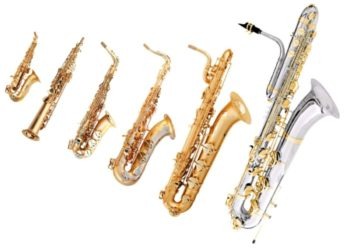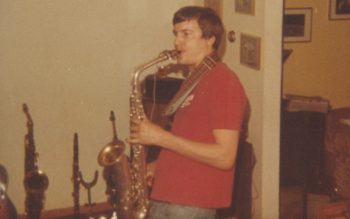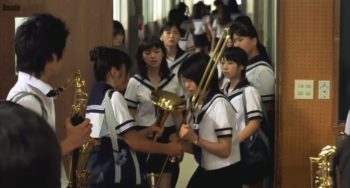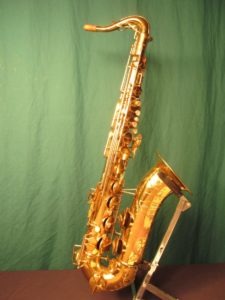By: Steve Candidus (Steve C.)
That’s Saxes, as in saxophones.

Overview:
Invented by Adolphe Sax and patented in 1846 they are classified as a single reed mouthpiece instrument usually made of brass. They fall into the woodwind family of musical instruments and there are more of them than you might think.
There are nine types in modern day classifications:
1) Sopranissimo – a straight sax keyed in Bᵇ – one octave higher than the soprano sax
2) Sopranino – a straight sax keyed in Eᵇ – one octave higher than the alto sax
3) Soprano – both straight and curved sax configurations keyed in Bᵇ – one octave higher than the tenor sax
4) Alto – a curved sax (although a very few straight altos were made) keyed in Eᵇ – one octave higher than the baritone sax
5) Tenor – a curved sax keyed in Bᵇ – one octave higher than the bass sax
6) Baritone – a curved sax keyed in Eᵇ – one octave higher than the contrabass sax
7) Bass – a curved sax keyed in Bᵇ – one octave higher than the subcontrabass
8) Contrabass – a curved sax keyed in Eᵇ – N/A
9) Subcontrabass – a curved sax keyed in Bᵇ – N/A
Why these keys:
There actually is a method to the madness of it. These keys were selected to best match up to military and marching bands. The player typically would never be required to transpose the music him or herself and other band instruments were also so keyed.
Saxophones were also designed specifically for use in concert orchestras and these were keyed in C. You rarely see a saxophone used in symphony orchestras although it’s probably more of a snob thing than any flaw of the sax or sound. The early masters didn’t write their music for saxophones, so the only time you see a sax used in concert orchestra they are brought out specifically for the piece being played and then sent back to the dungeons where such upstarts are kept chained and away from the tuxedo crowd. (Full disclosure here. Yes, I love classical music too).
Going out on a limb here, but I suspect that a large part of the reason that the great masters didn’t write music for the saxophone is because it hadn’t been invented yet.
Take that saxophone symphony snobs…
C-Soprano and C-Melody Saxophones:
In addition to the nine modern saxophones, there are also two that are keyed in C and are usually referred to as C-Soprano and C- Melody saxophones.
The C-Soprano came in both straight and curved configurations and was pitched one tone higher than the slightly larger Bᵇ soprano sax.
The C-Melody was a curved sax that was piched one whole step above the Bᵇ tenor sax. It came in both curved neck configurations like the Bᵇ tenor and also with a straight neck like an Eᵇ alto. This sax was between the alto and the tenor sax in size.
Although out of mass production for almost a century and not often found in professional use, saxophones keyed in C are enjoying a resurgence of popularity in local bands that are attracted by their advantage of not having to transpose from either Eᵇ or Bᵇ to play along with guitars, pianos, etc that are all keyed in C. They are often found in church ‘worship’ bands and because they made so many of them, they are easy to find in the used market.
I personally played a Conn straight neck C-Melody sax for years in rock bands where I was primarily the rhythym guitarist (I was never a very good guitarist) and I used a small mic connected to a pre-amp into my guitar pedal effects then into my guitar amp. It’s surprising the range of sounds that can produce. Not surprisingly the only leads I ever took in those bands were with the sax which I had played for decades and was far more comfortable with.
I had Buescher and Martin curved neck C-Melody saxophones, but I liked the Conn straight neck the best. I found it more comfortable to hold, and the sound was great.

Good heavens, is that twentysomething year old kid with the brown hair playing a lead on a Conn C-Melody sax at a band rehearsal actually me? Whatever became of that kid?
C-Soprano and C-Melody saxophones often get a bad rap for having poor intonation, but that’s really not true. Part of the reason they are citied for that is actually due to their not having been overhauled (set up) properly. Remember that they haven’t been manufactured in a long time so the expertise to do so is often lost. It’s also due to the scarce availability of original C-mouthpieces for them. Alto and tenor mouthpieces can be fashoned to use, but great care must be taken to ensure proper intonation.
Mine had perfect intonation with its original mouthpiece and it was the very last saxophone that I sold when I eventually stopped playing. Giving up that old Conn straight neck C-Melody was like losing a limb. I was in a tug-a-war with the buyer even after he paid me for it.
About ten years ago I discovered a fun Japanese made movie about a bunch of high school girls that learn to play in a jazz band and there is a scene where the character Sekiguchi has to turn her beloved trombone over to another girl and the tug-a-war that ensued with her just not wanting to part with it; made me think of my parting with that old Conn. I’ll speak more about that movie later in this essay.

The shy and sweet Sekiguchi fighting to keep her beloved trombone.
Material:
Saxophones have traditionally been made of brass. It’s an easy metal to form to the shape required and the material has been used on countless other musical instruments for ages so its qualities are well known.
Other metals such as copper, silver, and even gold have been used as a plating over the brass and lately some are even manufactured out of other metals like solid silver or bronze.
The intention is that by changing the materials that they are manufactured out of it effects the tone. I personally think it’s nonsense.
A string instrument like a guitar, a violin, or a piano have strings that vibrate OVER a wooden soundboard to create their tone so the types of wood will affect the tone. The sound of a saxophone emanates out of the bell of the horn, not from its sides. The solid silver Saxes produced by companies like Yanagisawa are beautiful instruments, albeit a bit heavier due to silvers higher density, but I don’t think that the sound is really effected much if at all.
If you want to alter or fine-tune the sound to your personal style or requirements for the type of music you intend to play with it, it’s much wiser in my opinion to match the neck and mouthpiece to your needs. They will affect the tone much more than the material the sax is made of. Someone even built a saxophone out of plastic a few years ago and it sounded like – guess what – a saxophone.
Straight versus curved sopranos:
I should start by saying that the soprano sax has never been a favorite with me. Its personal taste, but I just never warmed up to them. Both straight and curved are keyed in Bᵇ and should sound the same, but they don’t to my ears. I prefer the curved, but even though I have had both over the years, I never kept either for very long. Kenny G is probably the best-known player of straight soprano saxophones.
The neck:
The neck of a saxophone is one of the most critical parts for effecting the tone of the horn. The higher grade of professional horns like the aforementioned Yanagisawa offer a selection of slightly different types and configurations of necks. The neck and the mouthpiece will help to fine-tune or shape a saxophone to the player’s particular needs.
Personal favorites:
I played soprano, alto, tenor, baritone, and C-Melody Saxes over the years, but mostly alto’s and tenors. The C-Melody sax was for use in the rock bands. It was just easier to use without having to transpose the keys and being sort of a tweener of the alto and tenor sax, it gave me a nice range for the application.
I have many fond memories with that old Conn C-Melody sax. We traveled some together…
Since I favor the old big band jazz music though, if I had to choose just one saxophone it would be the tenor. I have had Buescher’s and Martin’s, mostly of the 1940-1950’s vintage, and they were wonderful. I learned to play on an old Buescher True Tone circa 1925. They are an excellent choice for the beginner even now. I have also had Selmer’s of the 1960’s vintage. The best of the best for me though were the Buescher 400 Top Hat and Canes. They were designed in the late 1930’s specifically for big band jazz. Being design-specific, they were magnificent at it.
They lack the advances in ergonomics and computer-assisted design of modern horns, but they had some unique features of their own. Instead of on the side of horn, they placed the low Bᵇ tone holes (those big ones on the bottom) on the back in between the bell and the rest of the horn’s body. That balanced the horn when activated, but required them to make the bottom bow larger. That serendipitously resulted in a smoother and much louder sound coming out the bell. Buescher 400’s were loud horns! The production sweet spot was about 1946-1954 before they started cheapening them up. If you like big band jazz this is the saxophone designed for it, so stop being such a wuss about the ergonomics, suck it up, and play it.

The magnificent Buescher 400 Top Hat and Cane tenor saxophone with a gold plated finish. Note the low Bᵇ tone holes on the back of the bell not on the side.
So now we take a detour to a fun movie with some wonderful music. Well, OK, some not so wonderful music through the parts where they are still learning, but they nail it at the end.
“Swing Girls”
‘Swing Girls’ (and a boy) was made in Japan starting in 2001 and finished in 2003. It was released in 2004.
It’s a Japanese comedy and its lots of fun. It’s definitely rated ‘G’. You can watch it with your spouse, the kids, grandma, the dog, etc. It’s a story about 16 high school girls that are the misfits of their school and families that finally find their place in life by playing big band jazz.
This movie always makes me smile. These kids were actors, not musicians. The director (also a saxophone player – go figure) wanted them to actually learn how to play their instruments so that they would understand their roles in the movie. He started by handing each of them an instrument in 2001 and telling them to go and learn how to play it and that when they were ready they would film the movie.
The kids then spent two years at the Yamaha Music School (Yamaha was one of the sponsors of the movie) learning how to play them and it’s actually them playing in the movie.
They became sort of a Phenom in Japan after the release of this movie and went on tour playing to live audiences.
I usually don’t like watching films with subtitles, but this one is surprisingly easy to follow with them. It’s too bad that this movie was never released in the US and just dubbed in (maybe with their own voices), but it’s still very enjoyable. It has never been available on DVD, but you might still find it with English subtitles in Blu-ray.
Other than the aforementioned Sekiguchi’s tug-a-war with her trombone and the grand finale concert which is excellent, two of my favorite scenes are the one where the girls are practicing their breathing by inhaling on plastic bottles (yeah I know – my bad). It’s the funniest 17 seconds of the movie. And yes, that’s the shy and sweet Sekiguchi again achieving the feat.

And the scene with the wild boar. Who wouldn’t love Louis Armstrong singing “What a Wonderful World” to some very clever photography?
https://www.youtube.com/watch?v=dHnaP88VYS0
I had intended to close this essay with a link to the whole movie with English subtitles, but YouTube has once again yanked it. We all know the drill. It will probably be re-posted by someone in a few weeks or months.
In the meantime, I will just close with a song from their final concert playing as a traditional 17-piece big band jazz ensemble, and yes, it was recorded in a studio and then dubbed into the movie, but it’s really those high school kids playing. The director was insistent on it. No substitutions.
I love seeing some young blood flowing into big band jazz. I think these kids are great!
The closing credits. Various out-take scenes from the movie where they each lip-sink the words to the song L-O-V-E sung by Nat King Cole in 1965.
Well, that’s it for our tour of the world of saxophones and a detour to a fun movie with some good big band jazz at the end. I hope you enjoyed it.
My thanks to my friend and fellow writer and traveler Peter Underwood (Austrian Peter) for proof reading this essay for me.
Steve Candidus is a writer and history buff that works as a product and application specialist of large AC electric motors in Spring, Texas.






I really enjoyed this essay. I learned quite a few new things. I can’t listen to the music now (I’m actually working) but plan to come back and listen this evening.
Vixon Vic thank you.
Of all people on TBP, I figured that you would like this essay.
I’m not sure how the monkeys are going to take it, but it was damned sure a lot of fun to write.
I think you will like the music too…
I love the music Steve, I have filed it and will play it while I write – it is so soothing and just right for me. Well done, great essay. VV said just the same as me, learned new things which is what TBP is about for me.
I’m glad that you liked it.
Thanks again for proof reading it for me. You are a good friend…
love all kinds of saxophone music, kaptain!
here’s a trip down memory lane for a lot of folks
But could he play saxophone? NOOOOOOOOOOO
And I have a better Earp then he had.
(Better not let Maggie see those bunnies or she’ll be here with her ball peen hammer)
Watch it!
I was first chair, first clarinet.
I had a crush on a saxophone player.
Right there, front and center. Long hair then… it was the style in 1978!
Was that first clarinet or a fast clarinetist?…
(The kiddies probably won’t know what ‘fast’ girl was)
I was a very studious young lady, then. The apple of Dad’s eye. He would get his harmonica out and play with me.
I’m serious.
I worked at a grocery store (meat department… I had a natural talent obvious to the butcher, who picked me out of a lineup of “checkers” at the IGA when his meat wrapper got caught stealing big slabs of meat.
He said he thought I looked like I could get my hands bloody and get over it. That was 1979, when a 30 year old butcher could say that to a seventeen year old kid and everybody laughed.
I’d grown up wrapping meat Dad butchered at home. Getting paid almost $4 an hour to do it was BONUS!
Not fast at all. However, that extra spending money got me up to speed pretty quickly, unfortunately.
Life lessons ahead… I tell her in this picture but she doesn’t listen.
Stucky wrote an article a few years back asking the question that if you could go back and talk to yourself when you were in high school what would you tell yourself?
Aside from the obvious “DON’T MARRY HER!” it is something that I have thought about ever since.
When someone can write something that makes you think about it for years that’s some good writing.
TBP has been very good to me. I have not only made friends within it, but Austrian Peter and I have become pretty good friends outside of it.
What a wonderful place this is…
It a trip down memory lane mixed in with a streetcar named desire.
Or, Desire, pronounced dez uh ray…
By the way? Too late. I already grabbed a time pointer and have gone huntin’ wabbit!
I looked and looked and looked but all I found was Mr. Rogers at a woodwind reed factory.
I swapped lots of spit with a certain sax player a time or two… via REED switching. Haha!
THANKS LOADS for the article, and especially the Swing tune by the kiddos.
I am musically illiterate, cannot carry a tune in a bucket, but a huge listener.
The sax player with Duane eddy the famous guitar player that has been with him for thirty years is a superb accompaniment to the guitar. A memory seared in the brain is a version of the Peter Gunn theme where after the first few bars of the band intro, a super sexy lady seductively comes out on stage and whips the unseen sax out from behind her back and hits it. Check it out.
Another fascinating thing I have been wondering about is the extraordinary craftsmanship required to make the instrument. Any videos on that subject?
Yamaha has a factory tour about manufacturing saxophones. I’ll have to see if I can find it.
You might try a Duck Duck Go search and see what you can find.
I haven’t seen any other factories showing sax construction.
Or check the science channel’s how its made series. I remember seeing a episode that went into a good deal of detail on building Saxophones.
How about this classic?
And it’s pronounced Bisher…
https://www.youtube.com/watch?v=2WxkofPZ_K0
THANKS loads for digging the manufacturing videos out.
At least as complex and detailed as I had suspected, which is why the curiosity.
The making of the really fine classical six string guitars the classical artists use is equally fascinating.
THANKS again!!!
I usually don’t like watching films with subtitles – Steve C.
It’s the only way to watch a movie made elsewhere. American made movies are crap. Crap! I had a work buddy who disliked watching a movie with subtitles and missed out on the better version of Vanilla Sky. That statement about not liking films with subtitles is a universal cop out, I learned to watch foreign movies in college where we could watch French movies.
I liked your article, I feel smarter about saxophones and it reminded me of my favorite video with uniformed girls playing saxophones.
We need to have someone make a note of this.
I agree with everything you wrote…
And thanks for the nice words about my article.
And hands off my shy and sweet Sekiguchi. I saw her first…
Really enjoyed that, Steve. Thanks. It’s neat when people share things they’re passionate about.
I had WW II generation parents who loved 1940s music (Big Band, Swing, & Jazz ) and when they danced, it could have made one heck of a YouTube tutorial today. They were really good.
Although I’m definitely not an aficionado, I always liked the happy little sax solo that plays at the end of Lou Reed’s “Walk on the Wild Side”.
Thanks again for the post
Thanks Doug.
To not be passionate about something is to be three quarters of the way dead already…
And nothing like a good Lindy Hop with some Jitterbug steps thrown in. Maybe we can get T4C to chime in about that.
Well at least there are more saxes then genders – nine versus two.
Love me some Paul Desmond, Stan Getz, and of course the ever-coolest sublime Gerry Mulligan:
Ultimate chill.
Oh, yeah…Yup.
I googled “swing girls” but didn’t find anything about saxophones……..
I was made to play the clarinet in the school band. One day somebody mentioned if you can play a clarinet you can play the sax. The fingering and embouchure are almost the same. Still have an old Boosey and Hawkes tenor sax I play occasionally.
Really enjoyed the article. Thanks
Go to YouTube and search for ‘Swing Girls’. You’ll get lots of shorts and some of their performances after the movie.
Most of it is in Japanese without subtitles though.
There’s also a video that shows them at the Yamaha Music school and of actually making the movie.
Lot’s a videos on Swing Girls…
Listen to some Gato Barbieri to put you and the wifey …in the mood.
Am wondering what your thoughts are on Amy?
What a great essay!!
I learned a lot and enjoyed it a lot too.
Thanks, Steve C.
You Tube is pissing me off.
Typed a nice comment Thanking you, Steve, with an attached YT music vid of Alone, by Kenny G.
Hit post, it logged here, I played the song, and the posted comment is nowhere to be found.
Arggh!
Anyway, great essay. Very informative.
You know my thoughts on orchestras, I’m sure.
Cheers
Put up a good version of Holst -Jupiter this Sunday.
I’ll follow you with the Japan Large Saxophone Ensemble playing the same.
That should be fun.
Dick Parry
These guys are pretty good too…
you too… what did you think about Amy Winehouse? I loved her jazzy sound and offbeat stage presence (when she wasn’t drunk and falling down)…
I think she could have made an international impact.
Thank God… an ascension from Clinton and Kenny Gs representation of a sax. I am grateful!
Mr. Steve,
this just popped up, and i think you will enjoy as much as me.
Especially as I am an OLD, as in many decades, Dave Brubeck fan.
E flat minor in 5/4 time with black sheets of music.
Brubeck was a genius.